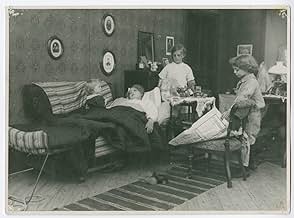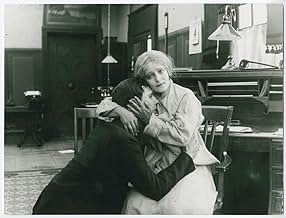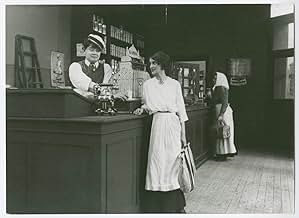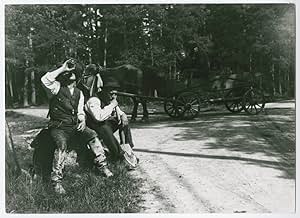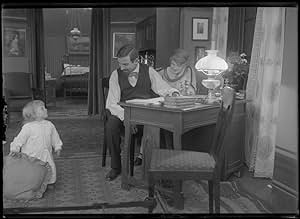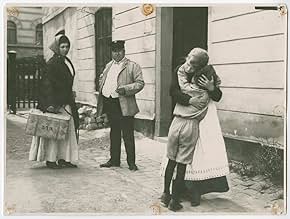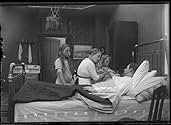IMDb-BEWERTUNG
7,0/10
1550
IHRE BEWERTUNG
Füge eine Handlung in deiner Sprache hinzuFinancial struggles separate a single mother from her children.Financial struggles separate a single mother from her children.Financial struggles separate a single mother from her children.
- Regie
- Drehbuch
- Hauptbesetzung
Empfohlene Bewertungen
Beautiful background music added to this Swedish silent film from 1913. This is first silent film I've seen and I didn't know what to expect. To my surprise, I was able to stay engaged for the full 73 mins and ended up enjoying the style in which the film is presented. The story of a widowed mother tugs at your heartstrings and is a bold commentary on the treatment of lower-class individuals (particularly women) at the time. Would recommend this film to anyone interested in deepening their understanding of European film from the early 20th century. I would not recommend this film to anyone looking to tune out to a relaxing (somewhat short) film.
A woman loses her husband and children in quick succession as the hand of fate lands her a tragic blow. Good direction, cinematography and acting for the time make this one of the essential silents and a standout in Scandinavian and world cinema. A must for fans of film history and movies in general.
Again, this is an early not-that-bad drama from Sjostrom about a person driven mad by tragic circumstances. It has a nice sense of restraint, especially for its era, with a fine performance by Hilda Borgstrom and a well-paced story. Nothing about the movie sucks. It just takes a little something extra for me to get involved with a silent film... some sort of avant-garde twist or dazzling technique or some thrilling action. Yeah, it's a good plot with a sympathetic protagonist, but my heart just wasn't in it. I can't imagine anyone besides a Sjostrom scholar watching this more than once.
6/10
6/10
10mmipyle
Over the weekend I watched "Ingeborg Holm" (1913), directed by Victor Sjöström, and starring Hilda Borgström as Ingeborg. This early Swedish feature is 96 minutes long, and it has recently been released by Kino Video. I must admit that the film rather astonished me because of the quality of pacing, of acting, of story - nearly everything; others from this year and before that were anything near a feature length, for the most part, are exceedingly antiquated by modern standards. "Ingeborg Holm" is anything BUT antiquated. I recently watched "Terje Vigen" (1917), also directed by Sjöström, and was riveted from beginning to end. It made me want to see more of his work. This became available to me, and I eagerly watched it. It certainly didn't disappoint. The story concerns what were called "workhouses" in Scandinavia. It begins by showing Ingeborg Holm's husband, through diligence and good economic behavior, being able to begin to operate his own grocery store. Unfortunately, just after opening, the husband suffers a hemorrhage and dies. Ingeborg takes over the running, but unfortunately, through the untoward grafting of an employee she ends up bankrupt. She and her three children are left with a choice to take 20 kronor a month or for Ingeborg to go work in a workhouse. She chooses the latter. I won't give away all the plot, but you can be sure that she suffers the incredible inhumanity that was inherent in that system at the time. It is said that this film nearly single-handedly began an improvement in the social system of Sweden.
I can't say enough nice things about this film because the comparison that most Americans will make will be with D. W. Griffith. Griffith only compares in a few shorts by 1913, maybe "Female of the Species", and others like it. But his next year's (1914) "Judith of Bethulia" doesn't begin to compare favorably with "Ingeborg Holm". "Ingeborg Holm"'s pacing is superb, its plot line developed as many feature silents wouldn't be for years yet. The acting has moments of early histrionic style, but for the most part it is remarkably realistic and measured. The film could bring tears to some. For me, it was a wonder to behold such an early film with such high quality.
The lead is Hilda Borgström. There were moments, especially near the end, where her eyes kept reminding me of Bette Davis. Those who have seen "Whatever Happened to Baby Jane?" will see the eye comparison immediately! Also, the man who plays the Poorhouse Superintendent, Georg Grönroos, looks so much like the American President, Theodore Roosevelt, as to be uncanny. His habit of taking off and putting on his reading glasses is so similar as to make one wonder if he wasn't copying Roosevelt. Anyway, it was nearly unnerving at times! One more note: the film, as with many of the period, is divided into acts, each act obviously following the length of a reel. At the end of each reel there is considerable nitrate deterioration. At the end of the picture there is massive deterioration, but still not enough to not be able to follow the picture. Overall, the quality is first rate, the picture usually quite good, if not excellent. If you're a fan of silent film, especially early silents, and if you like social drama, this is an outstanding way to quickly go through 96 minutes!
I can't say enough nice things about this film because the comparison that most Americans will make will be with D. W. Griffith. Griffith only compares in a few shorts by 1913, maybe "Female of the Species", and others like it. But his next year's (1914) "Judith of Bethulia" doesn't begin to compare favorably with "Ingeborg Holm". "Ingeborg Holm"'s pacing is superb, its plot line developed as many feature silents wouldn't be for years yet. The acting has moments of early histrionic style, but for the most part it is remarkably realistic and measured. The film could bring tears to some. For me, it was a wonder to behold such an early film with such high quality.
The lead is Hilda Borgström. There were moments, especially near the end, where her eyes kept reminding me of Bette Davis. Those who have seen "Whatever Happened to Baby Jane?" will see the eye comparison immediately! Also, the man who plays the Poorhouse Superintendent, Georg Grönroos, looks so much like the American President, Theodore Roosevelt, as to be uncanny. His habit of taking off and putting on his reading glasses is so similar as to make one wonder if he wasn't copying Roosevelt. Anyway, it was nearly unnerving at times! One more note: the film, as with many of the period, is divided into acts, each act obviously following the length of a reel. At the end of each reel there is considerable nitrate deterioration. At the end of the picture there is massive deterioration, but still not enough to not be able to follow the picture. Overall, the quality is first rate, the picture usually quite good, if not excellent. If you're a fan of silent film, especially early silents, and if you like social drama, this is an outstanding way to quickly go through 96 minutes!
Ingeborg Holm / Margaret Day (1913) :
Brief Review -
Master Victor Sjöström's Swedish Melodrama is one of the earliest notable works about a mother's Tragedy in the cinema world. I am a big fan of Victor Sjöström and his prominent classics from the 1920s decade. It gives me an immense pleasure to view his early films, which were made on basic formulas as per the requirements and understanding of the era. Ingeborg Holm forced me to think about all the films based on Mother's tale, and I quickly realised how influential it was. It was much before Chinese cinema made "SheNu" / "The Goddess" (1934) and Indian cinema made the classic "Aurat" (1940). However, Holm's story is not that broad. It sticks to the basics while dealing with a relatable and emotional topic like motherhood. When I tried to find out the similarities between this film and other ones, I found the Marathi film "Chimni Pakhare" close to it, but then the main character had to go through different conflicts. The best close answer was the Telugu flick, "Jeevana Jyothi" (1975), which also had a double role boost. Imagine, a film from the 1910s decade influencing modern well-known films. The film is about a mother with three children who had to send her children to foster homes due to the financial crisis after her husband's death. The insanity angle is also used well by mixing it with high-end melodrama. I remember Hilda Borgström from Victor's "The Phantom Carriage" (1921), but today I noticed that her face and expressions are familiar with those of Lillian Gish. Her face kept reminding me of Gish, who also happened to work during the same period of time. Victor Sjöström's film has everything to make a classy watch, but it missed the classic tag by just an inch, in my opinion. Nevertheless, a great work from the early stages of movies that set many iconic formulas once and for all.
RATING - 7.5/10*
By - #samthebestest.
Master Victor Sjöström's Swedish Melodrama is one of the earliest notable works about a mother's Tragedy in the cinema world. I am a big fan of Victor Sjöström and his prominent classics from the 1920s decade. It gives me an immense pleasure to view his early films, which were made on basic formulas as per the requirements and understanding of the era. Ingeborg Holm forced me to think about all the films based on Mother's tale, and I quickly realised how influential it was. It was much before Chinese cinema made "SheNu" / "The Goddess" (1934) and Indian cinema made the classic "Aurat" (1940). However, Holm's story is not that broad. It sticks to the basics while dealing with a relatable and emotional topic like motherhood. When I tried to find out the similarities between this film and other ones, I found the Marathi film "Chimni Pakhare" close to it, but then the main character had to go through different conflicts. The best close answer was the Telugu flick, "Jeevana Jyothi" (1975), which also had a double role boost. Imagine, a film from the 1910s decade influencing modern well-known films. The film is about a mother with three children who had to send her children to foster homes due to the financial crisis after her husband's death. The insanity angle is also used well by mixing it with high-end melodrama. I remember Hilda Borgström from Victor's "The Phantom Carriage" (1921), but today I noticed that her face and expressions are familiar with those of Lillian Gish. Her face kept reminding me of Gish, who also happened to work during the same period of time. Victor Sjöström's film has everything to make a classy watch, but it missed the classic tag by just an inch, in my opinion. Nevertheless, a great work from the early stages of movies that set many iconic formulas once and for all.
RATING - 7.5/10*
By - #samthebestest.
Wusstest du schon
- WissenswertesNoted as the first true narrative film, its remarkable narrative continuity would characterize the style now known as classical Hollywood, which dominated the global film industry for the majority of the century.
- VerbindungenFeatured in Victor Sjöström - ett porträtt av Gösta Werner (1981)
Top-Auswahl
Melde dich zum Bewerten an und greife auf die Watchlist für personalisierte Empfehlungen zu.
Details
- Laufzeit
- 1 Std. 36 Min.(96 min)
- Sound-Mix
- Seitenverhältnis
- 1.33 : 1
Zu dieser Seite beitragen
Bearbeitung vorschlagen oder fehlenden Inhalt hinzufügen

